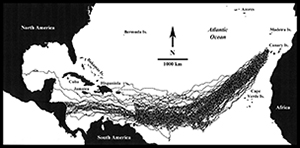Article contents
Drift voyages across the mid-Atlantic
Published online by Cambridge University Press: 05 June 2015
Extract

Pre-Columbian transoceanic contacts have long been controversial. The controversy stems from the fact that those supporting arguments for such crossings have often not evaluated the evidence as critically as was necessary. On the other hand, those dismissing these arguments have frequently ignored the inevitability of such events over long periods of time. One aspect of these debates that is seldom evaluated is the likelihood of vessels, with or without survivors, or floating artefacts, crossing oceans. As an example, a recent debate (Hristov & Genovés 1999, 2011; Shaaf & Wagner 1999; Smith 2011) centred on the head of a Roman figurine purportedly discovered in a pre-Columbian context at the site of Tecaxic-Calixtlahuaca in Mexico. Neither argument for or against the veracity of the pre-Columbian context of the artefact discusses how likely drift events are across the mid-Atlantic.
- Type
- Debate
- Information
- Copyright
- Copyright © Antiquity Publications Ltd, 2015
References
- 3
- Cited by




